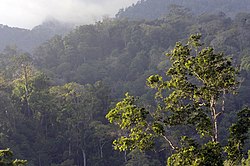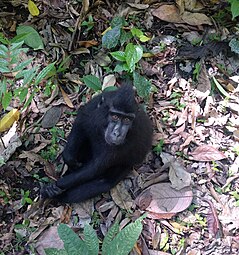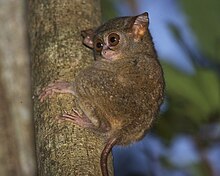Tangkoko Duasaudara reserve
The jungle reserve Tangkoko Duasaudara (also Dua Saudara ) extends around the 1351 m high Gunung Duasaudara ( Gunung indones. 'Mountain') and parts of the 1109 m high Gunung Tangkoko in the extreme northeast of Sulawesi . The usual entrance to the 8890 hectare reserve is in Batu Putih , a coastal village 60 km away from Manado , about 29 km from Bitung . The reserve has a well-grown secondary forest , which primarily consists of a large number of Ficus species. Primary forest can only be found in the summit region .
In 1919 the Gunung Tangkoko was declared a natural monument by the Dutch colonial government, and in 1942 the core area was declared a protected area. In 1978 the neighboring 4421 hectare area around the Duasaudara was added. It is not a national park .
nature
Bird life

The reserve's bird life is extremely rich with at least 233 species, 103 of which are endemic to Sulawesi . Two hornbills of 54 species worldwide are known from the island, the hornbill ( Aceros cassidix ) is native to the reserve. Especially since it is a very diverse ficus forest, the fruits of which are their preferred food; with which they in turn ensure their spread. The area has the highest density of hornbills in the world at 51 birds / km². With the Indonesian name rangkong or burung tahun (German for "annual bird"), the locals express their assumption that the red rings at the base of the beak indicate the age, similar to the annual rings on trees.
The endangered hammer grouse ( Macrocephalon maleo ) can also be found here. Its main occurrence is concentrated in an area approximately 8 km east of Batu Putih.
The devil night swallow ( Eurostopodus diabolicus ), a crepuscular ground-breeder, is also endemic . The bronze fruit dove ( Ducula aenea ) , which is up to 45 cm tall and weighs 365 g, with conspicuous green wing-coverts and a white underside, and the blue-black metallic shiny spot drongo ( Dicrurus hottentottus ) with its forked "fish tail" should also be mentioned. Become rare is the white-bellied sea eagle ( Haliaeetus leucogaster ), often you hit the Brahminy against the shoreline and lake shores.
Mammals
A rarity of the first order are two species of cuscus that only occur east of the Wallace Line . The bear cuscus ( Ailurops ursinus ) is the largest and most primitive representative and the more frequent sighting with over one meter from head to tail. The soil cuscus ( Strigocuscus celebensis ) probably only arrived from New Guinea about 11,000 years ago during the last great ice age, presumably by natural raft.
Native is also the lap parson or -makake ( Macaca nigri ). These monkeys live in large matriarchal groups of 30 to 100 individuals. 20 years ago there were at least 3000 in the area of the protected area, today there are at most 700.
There are three species of tarsier on the island. The tarsier species Tarsius spectrumgurskyae is tiny, barely double the size of a fist and also lives in the protected area. Also worth mentioning is the black fruit bat ( Pteropus alecto ), which lives in all of eastern Indonesia and northern Australia and is characterized by dark fur.
tourism
The protected area is visited by national and increasingly international tourists. It is relatively easy to access from the well-known diving island of Bunaken or Manado after a two-hour drive and from the diving island of Lembeh after a one-hour journey.
literature
- Margaret F. Kinnaird: North Sulawesi - A natural history Guide . Development Institute Wallacea, (1995), no longer published (in English)
- Lee / Riley / Pesik: Pocket Guide Tangkoko Duasaudara Nature Reserve (2008), very detailed, very informative, available from Safari Tours & Travel and selected accommodations, Manado
Web links
- Klaus Polak More detailed description of biodiversity with photos, travel journalistic references
Individual evidence
- ↑ Hyginus Hardoyo: Nature lovers committed to preserve nature , The Jakarta Post , May 6, 2008.
Coordinates: 1 ° 31 '5 " N , 125 ° 11' 10" E


